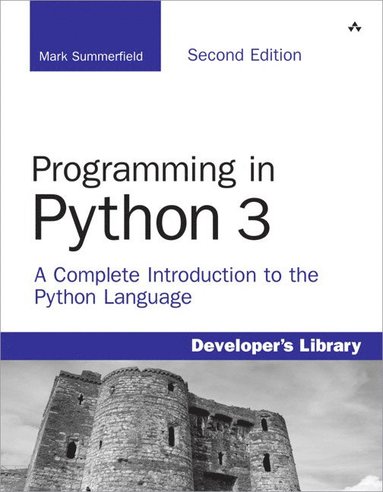
- Format
- Häftad (Paperback)
- Språk
- Engelska
- Antal sidor
- 648
- Utgivningsdatum
- 2009-11-24
- Upplaga
- 2
- Förlag
- ADDISON-WESLEY
- Illustrationer
- illustrations
- Dimensioner
- 228 x 181 x 32 mm
- Vikt
- Antal komponenter
- 1
- ISBN
- 9780321680563
- 1067 g
Programming in Python 3: A Complete Introduction to the Python Language
Slutsåld
Kundrecensioner
Fler böcker av Mark Summerfield
-
Programming in Go
Mark Summerfield
Your Hands-On Guide to Go, the Revolutionary New Language Designed for Concurrency, Multicore Hardware, and Programmer Convenience Today's most exciting new programming language, Go, is designed from the ground up to help you easily leverage all t...
-
Python in Practice
Mark Summerfield
Winner of the 2014 Jolt Award for "e;Best Book"e; "e;Whether you are an experienced programmer or are starting your career, Python in Practice is full of valuable advice and example to help you improve your craft by thinking about prob...
Recensioner i media
Fulfills the immediate market need for those developers seeking to learn this latest evolutionary version of the Python lineage in a succinct, well-written package.
Mike Riley, Contributing Editor for Dr. Dobbs
Beyond the introduction to programming in Python 3 in the first chapter, if you progress through the first six chapters in sequence, youll be well on your way to taking off with using Python independently.
James Pyles, Technical Writer and Author of the blog A Million Chimpanzees
A key recommendation for any serious computer library strong in web programming languages.
Jim Cox, Midwest Book Review
Summerfields book is an excellent source to start learning Python 3.
Anthony J. Duben, Computing Reviews
Övrig information
Mark Summerfield graduated in computer science with first class honors from the University of Wales Swansea. He followed this with a year's postgraduate research before going into industry. He spent many years working as a software engineer for a variety of firms before joining Trolltech. He spent almost three years as Trolltech's documentation manager, during which he founded and edited Trolltech's technical journal, Qt Quarterly. Mark is the coauthor of C++ GUI Programming with Qt 3 and C++ GUI Programming with Qt 4, and author of Rapid GUI Programming with Python and Qt: The Definitive Guide to PyQt Programming. Mark owns Qtrac Ltd., www.qtrac.eu, where he works as an independent author, editor, trainer, and consultant, specializing in C++, Qt, Python, and PyQt.
Innehållsförteckning
List of Tables xv
Introduction 1
Chapter 1: Rapid Introduction to Procedural Programming 9
Creating and Running Python Programs 9
Pythons Beautiful Heart 14
Examples 39
Summary 44
Exercises 47
Chapter 2: Data Types 51
Identifiers and Keywords 51
Integral Types 54
Floating-Point Types 58
Strings 65
Examples 94
Summary 102
Exercises 104
Chapter 3: Collection Data Types 107
Sequence Types 107
Set Types 120
Mapping Types 126
Iterating and Copying Collections 138
Examples 148
Summary 156
Exercises 158
Chapter 4: Control Structures and Functions 159
Control Structures 159
Exception Handling 163
Custom Functions 171
Example: make_html_skeleton.py 185
Summary 191
Exercise 192
Chapter 5: Modules 195
Modules and Packages 195
Overview of Pythons Standard Library 212
Summary 230
Exercise 231
Chapter 6: Object-Oriented Programming 233
The Object-Oriented Approach 234
Custom Classes 238
Custom Collection Classes 261
Summary 283
Exercises 285
Chapter 7: File Handling 287
Writing and Reading Binary Data 292
Writing and Parsing Text Files 305
Writing and Parsing XML Files 312
Random Access Binary Files 324
Summary 336
Exercises 337
Chapter 8: Advanced Programming Techniques 339
Further Procedural Programming 340
Further Object-Oriented Programming 363
Functional-Style Programming 395
Example: Valid.py 407
Summary 410
Exercises 411
Chapter 9: Debugging, Testing, and Profiling 413
Debugging 414
Unit Testing 425
Profiling 432
Summary 437
Chapter 10: Processes and Threading 439
Using the Multiprocessing Module 440
Using the Threading Module 444
Summary 454
Exercises 455
Chapter 11: Networking 457
Creating a TCP Client 458
Creating a TCP Server 464
Summary 471
Exercises 471
Chapter 12: Database Programming 475
DBM Databases 476
SQL Databases 480
Summary 487
Exercise 488
Chapter 13: Regular Expressions 489
Pythons Regular Expression Language 490
The Regular Expression Module 499
Summary 509
Exercises 510
Chapter 14: Introduction to Parsing 513
BNF Syntax and Parsing Terminology 514
Writing Han...
Du kanske gillar
-
Nexus
Yuval Noah Harari
Häftad -
Careless People
Sarah Wynn-Williams
Inbunden -
Doppelganger
Naomi Klein
Häftad
